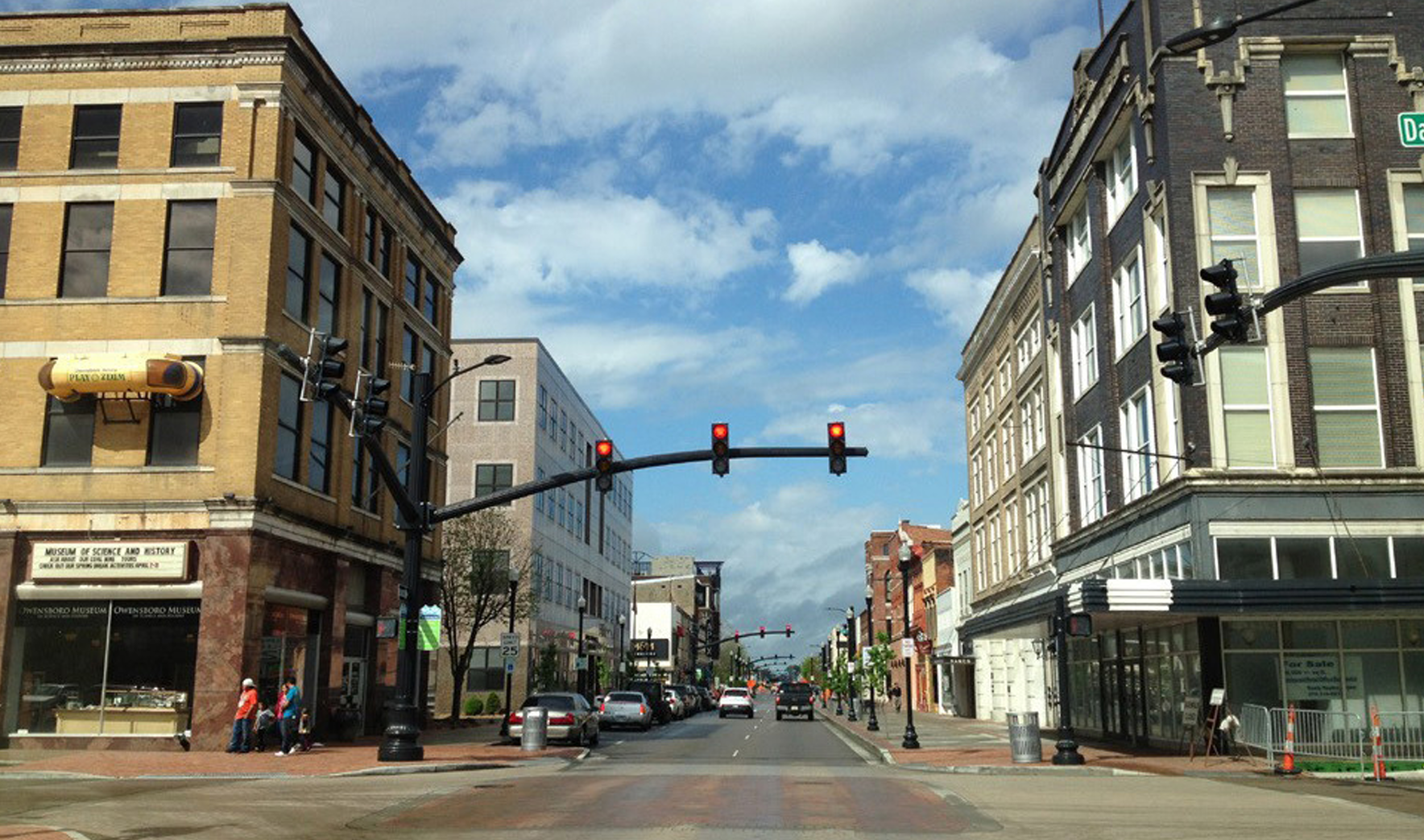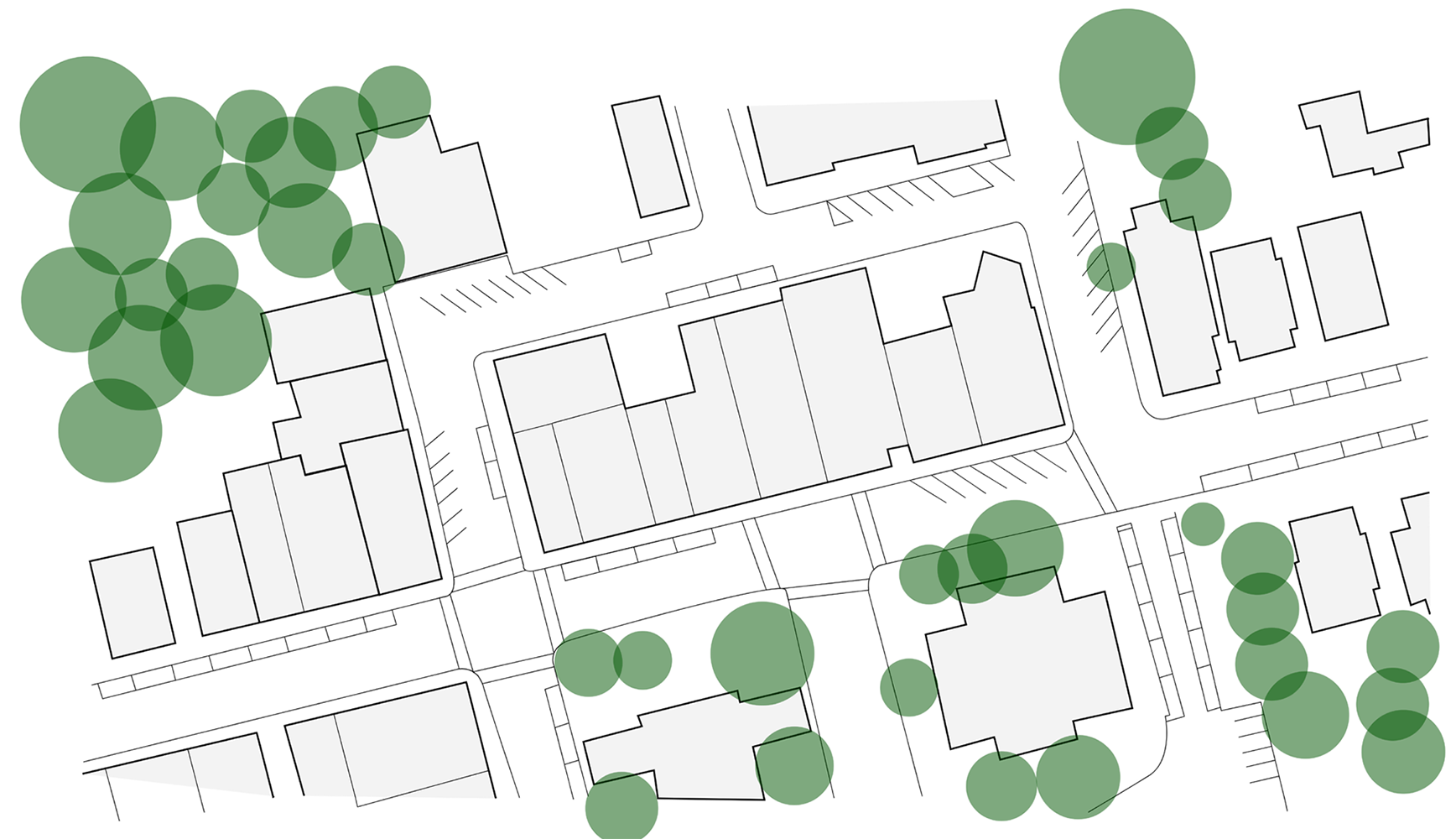Publication | Streetscapes: Visioning Vibrant Relationships
Publication | Streetscapes: Visioning Vibrant Relationships

WHAT IS A STREETSCAPE?
Every day people travel along streets for a variety of activities whether on foot, on a bike, or in a car. A streetscape is the sphere that includes the public right-of-way (ROW) from the edge of properties on both sides of the street. The streetscape typically includes a mix of features including but not limited to vehicular lanes, sidewalks, bike lanes, parking spaces, planting strips, storm water management elements, signage, street lights, utility lines, amenities such as bus stops, and facades of built structures. A successful streetscape design conveys a safe, environmentally friendly, aesthetically appealing, inclusive, and context sensitive atmosphere to the area, neighborhood, or district. In addition, established streetscapes enhance the functionality, accessibility, and vitality of the built environment.
Vibrant streetscapes are social places that support and encourage multiple uses. Crankshaw suggests that streetscapes and public space designs should facilitate a range of activities such as farmers markets, parades, and music events to allow for a variety of social gatherings. Well-designed streetscapes encourage people to spend more time socializing and to revisit frequently. Ultimately, the goal of a streetscape project is to incorporate elements that contribute to making streets into destination places by being pedestrian-oriented while providing adequate vehicular circulation.
In the early twentieth century, urban transportation infrastructure established the basic interlocking patterns observed in most towns and cities. By the mid-twentieth century, such traditionally gridded streets evolved into venues with an emphasis on organic/curvilinear physical patterns. These curvy street patterns were perceived as ideal at the time but resulted in cookie-cutter development. This repetition has resulted in places that lack character or identity and seem to be from anywhere or nowhere at the same time.
Many current streetscapes are typically overwhelmed by the volume of vehicles, with their distracting noises and smells, passing through the public spaces. Dover and Massengale suggest that modern forward thinking streetscapes need to focus on rediscovering towns, rebuilding streets, prioritizing people, and curtailing dependence on vehicles. Streets are important areas within our built environment as they not only connect the different types of land uses but also serve as the edges of the different land uses.
The hierarchy of the types of streets and elements within are similar in function and form; however, depending on who leads a street project—transportation planners, engineers, or urban designers—streets may be labeled differently (Table 1).
Table 1. Types of streets classified by different planning disciplines working on streetscape projects
TRANSPORTATION ENGINEERING/PLANNING
- Highway
- Arterial
- Collector
- Local
- Cul-de-sac
- Driveway
URBAN PLANNING/DESIGN
- Parkway
- Boulevard
- Avenue and Connector
- Street and Road
- Close
- Alley and Lane
STREET ELEMENTS
- Multiple lanes, side/shoulder
- Multiple lanes, side/shoulder
- Multiple lanes, median, sidewalk, side/shoulder
- Fewer lanes, median/parking, sidewalk, side/shoulder
- Single lane, sidewalk
- Single lane
Source: Adapted from Dover and Massengale
Understanding the variety of street classifications will help the working community to better understand limitations and potentials of enhancing the different types of streetscapes with a range of solutions.
Typically, most streets fall under the public realm unless a street is a private corridor. Streetscapes can be created where there is a variety of public and private ownership of the built environment. Ideally, streetscapes are meant to serve the public in a range of places from downtown civic districts to residential areas at the edges of towns with a mix of street elements. Streetscapes often have relationships with private properties as backdrops and destinations or as attractions that are open to servicing the public. Successful streetscapes will contribute to a community’s sense of place, first impressions, economic activity, and physical health.
Some community design strategies incorporate streetscapes into transportation, planning, or environmental sustainability projects to increase pedestrian activities, support alternative travel modes, and enhance ecosystem health. As an example, Complete Streets is a concept developed and promoted by Smart Growth America, National Complete Street Coalition, which includes features to address a range of different travel modes, such as walking, cycling, and driving, in a safe and convenient way. Streetscapes come in different shapes and sizes but overall can serve many roles in improving a community’s physical environment (Table 1, Figure 1).
Figure 1
Components of a streetscape. Downtown Nicholasville, Kentucky

CHALLENGES AND BENEFITS
Streetscape projects depend on both process and product (Table 2).
Table 2. Benefits and challenges of streetscape projects
PROCESS
Benefits
- Build relationships through collaboration, coordination, and cooperation
- Identify new partners and resources
- Develop agreements and consensus building
Challenges
- Obtaining and allocation of funds
- Conflict resolution, reaching consensus
- Timely implementation
- Acquiring vacant or abandoned property
PRODUCT
Benefits
- Connect destinations, sidewalks, bike lanes
- Direct/indirect economic activity
- Physical enhancement of the built environment
- Enhanced alternative travel mode opportunities
Challenges
- Disconnect of sidewalks, bike lanes
- Confusing aesthetics
- Difficult to control quality and aesthetics
- Lack of central/strong management of projects with multi-partner ownership
The very nature of a street embodies conflicting travel modes. As a result, it is not always easy or clear how to address conflicting issues and areas except to acknowledge and inform potential users to be aware of others. Challenges for streetscape projects may include but are not limited to existing buildings, predefined work areas, design codes and standards, resistance from the community, environmental impacts, maintenance concerns, lack of guidelines, and funding issues. In addition, streetscape projects are challenging from the outcome or product side as it is difficult to keep the visual look of streetscapes consistent, to keep retail spaces occupied with minimal vacancies, and to keep up the maintenance of streets.
With all of the above considered, a successful streetscape design can have positive impacts on the economy, the environment, and the community at large. The standardized elements of streetscape design should be safe, beautiful, functional, and easy to repair and maintain.
WHY CARE ABOUT YOUR STREETSCAPE?
Sound, well-designed streetscapes accommodate alternative forms of travel, including automobiles. The safety and comfort of pedestrians, cyclists, and public transit users is addressed in inclusive streetscape designs. Such efforts can help promote and support healthier behavioral habits among residents and visitors while also reducing community issues such as pollution and traffic congestion. Amenities such as waiting areas or bus stops can promote the use of public transportation while also providing protection from vehicles and exposure to rain, snow, wind, or extreme sun. Designated bike lanes and appropriate bike parking features can encourage biking, and functional and aesthetically pleasing sidewalks can encourage foot traffic, activities which not only influence an individual’s health but also commerce in a community
Communities should plan and design ideal streetscapes for multiple beneficiaries while minimizing use conflicts. Streetscape design should clearly allocate space for different travel modes with minimal overlap so that users are aware of what to expect in certain routes and areas. Furthermore, streetscape designs should provide pleasant experiences, particularly for pedestrians and those moving slowly. Streetscape projects will present different problems and scenarios but should culminate with a creative, functional, and lasting public space. Intentional streetscape design can improve traffic flow, safety, aesthetics, and the environment and its relationship to users (Table 3).
Table 3. Goals and objectives of streetscape projects
GOALS
- Improve traffic flow
- Revitalize economic activity
- Enhance pedestrian experience
- Create a greener environment
- Beautify the street and surroundings
- Increase safety for pedestrians and vehicles
OBJECTIVES
- Increase public gathering opportunities with street furniture
- Improve building facades and user amenities
- Facilitate parking and parking availability
- Increase number of street trees and plants/land scaping for beauty and environmental health
- Improve stormwater management which directly impacts the environment
- Increase foot traffic and improve vehicular flow
- Encourage bicycle traffic with bike lanes and racks
OUTCOMES
- Enhance aesthetics
- Attract new businesses
- Increase foot traffic
- Improve safety for pedestrians, motorists & cyclists
- Reduce environmental impact from stormwater runoff and vehicular traffic
EXAMPLES
- Downtown corridors
- Residential streets
- Commercial districts
- Boulevards
- Country lanes
- Scenic routes
CONCLUSION
While the development of a successful streetscape project has its challenges, the economic, social, and environmental benefits frequently outweigh the costs. Well-planned and designed streetscapes will provide safe and comfortable public spaces that can achieve a range of community goals, from economic health to physical health and wellness.
REFERENCES
Crankshaw, N. (2009). Creating Vibrant Public Spaces: Streetscape Design in Commercial and Historic Districts. Washington, DC; Covelo, CA; London, UK: Island Press.
Dover, V., and J. Massengale (2014). Street Design: The Secret to Great Cities and Towns. Hoboken, NJ: John Wiley & Sons, Inc.
Smart Growth America, National Complete Street Coalition (n.d.). Implementing complete streets: Sustainable complete streets. http://www.smartgrowthamerica.org/completestreets/implementation/factsheets/green-streets/
Speck, J. (2012). Walkable City: How Downtown Can Save America, One Step at a Time. New York, NY: Farrar, Straus and Giroux.
To contact the author or to request technical assistance with wayfinding or community design, visit the Blueprint Kentucky website: https://blueprintkentucky.mgcafe.uky.edu.


